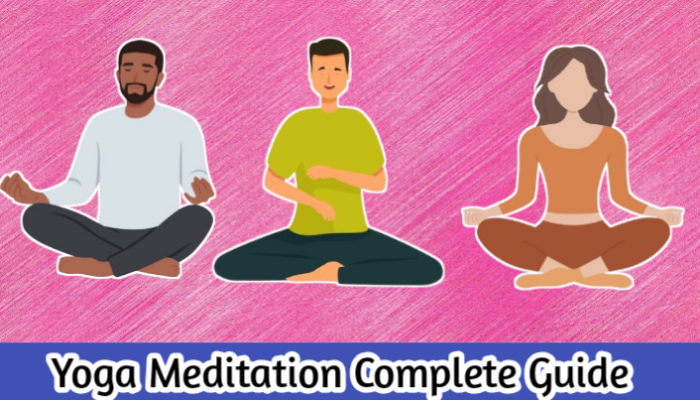Yoga meditation is a holistic practice that blends physical postures (asanas), breathing techniques (pranayama), and focused mental exercises. Its goal is to unite the body, mind, and spirit, fostering inner peace, clarity, and overall well-being. Unlike simple meditation, yoga meditation integrates movement, breath, and mindfulness, making it a full-body experience.
1. History and Origins of Yoga Meditation
- Originated in ancient India over 5,000 years ago
- Rooted in Vedic traditions, later systematized by Patanjali in the Yoga Sutras
- Initially practiced for self-realization, mental discipline, and spiritual awakening
- Modern adaptations focus on stress relief, fitness, and mental clarity worldwide
2. Types of Yoga Meditation Practices
2.1 Mindfulness Meditation
- Focuses on present-moment awareness
- Observes thoughts, emotions, and sensations without judgment
- Benefits: Reduces stress, improves focus, enhances emotional resilience
2.2 Mantra Meditation
- Repetition of a specific word, phrase, or sound (e.g., “Om”)
- Helps concentrate the mind and block distractions
- Benefits: Promotes calmness, mental clarity, and spiritual connection
2.3 Breath-Focused Meditation (Pranayama)
- Concentration on inhalation, exhalation, and breath control
- Techniques: Alternate nostril breathing, deep diaphragmatic breathing
- Benefits: Reduces anxiety, boosts energy, improves lung capacity
2.4 Chakra Meditation
- Focuses on seven energy centers (chakras) in the body
- Uses visualization, chanting, or breathwork to balance energy flow
- Benefits: Emotional balance, spiritual alignment, stress relief
2.5 Guided Visualization
- Practitioner follows imagery or mental scenarios guided by voice or music
- Often includes nature, light, or calming imagery
- Benefits: Enhances relaxation, creativity, and emotional healing
3. Benefits of Yoga Meditation
3.1 Physical Benefits
- Improves flexibility, posture, and muscle tone
- Boosts circulation and reduces tension
- Supports healthy sleep patterns
3.2 Mental Benefits
- Reduces stress, anxiety, and mental fatigue
- Improves focus, concentration, and memory
- Enhances mindfulness and mental clarity
3.3 Emotional Benefits
- Promotes emotional balance and resilience
- Reduces irritability, anger, and negative thinking
- Encourages self-awareness and inner peace
4. Basic Techniques to Start Yoga Meditation
4.1 Finding a Comfortable Position
- Sit on a mat, chair, or cushion with a straight spine
- Relax shoulders and keep legs crossed or comfortably folded
4.2 Breath Awareness
- Focus on slow, deep breathing
- Inhale through nose, exhale slowly through nose or mouth
- Sync breath with body sensations for mindfulness
4.3 Focusing the Mind
- Bring attention back gently when thoughts wander
- Use mental anchors: breath, mantra, or bodily sensations
4.4 Using Mantras or Visualization
- Repeat calming words or visualize peaceful imagery
- Helps deepen concentration and enhance inner calm
5. Step-by-Step Yoga Meditation Routine
5.1 Preparation and Environment
- Quiet, clean space with minimal distractions
- Optional: dim lighting, candles, or incense
5.2 Warm-Up Yoga Poses
- Cat-Cow, Forward Fold, Child’s Pose
- Prepares body for sitting meditation
5.3 Meditation Session (5–30 minutes)
- Select a meditation type: mindfulness, mantra, or breath-focused
- Maintain comfortable posture, relax body, and focus mind
5.4 Closing and Reflection
- Slowly open eyes and stretch lightly
- Reflect on physical sensations, mental state, and emotions
6. Common Challenges and How to Overcome Them
6.1 Difficulty Concentrating
- Start with short sessions (5–10 minutes)
- Use breath or mantra as an anchor
6.2 Physical Discomfort
- Adjust posture or use props like cushions or blocks
- Stretch gently before meditation
6.3 Mental Restlessness
- Accept wandering thoughts without judgment
- Gently return focus to breath, mantra, or visualization
7. Tips for Deepening Your Yoga Meditation Practice
7.1 Consistency and Routine
- Meditate daily at a fixed time
- Even 5–10 minutes daily can bring noticeable benefits
7.2 Mindful Breathing Techniques
- Practice deep diaphragmatic breathing or alternate nostril breathing
- Improves focus, reduces stress, and balances energy
7.3 Incorporating Mindfulness in Daily Life
- Mindful eating, walking, or working
- Promotes overall awareness and reduces automatic stress responses
8. Recommended Yoga Meditation Practices for Different Goals
8.1 Stress Relief
- Mindfulness meditation or restorative yoga
- Focus on deep breathing and body awareness
8.2 Improving Focus and Productivity
- Breath-focused meditation (Pranayama)
- Enhances concentration, mental clarity, and alertness
8.3 Emotional Healing
- Chakra meditation or guided visualization
- Helps release emotional blockages and promotes self-awareness
8.4 Spiritual Growth
- Kundalini meditation or mantra meditation
- Promotes spiritual awakening, energy alignment, and inner peace
9. Conclusion
Yoga meditation is a powerful tool for holistic well-being. By combining movement, breathwork, and mental focus, it helps:
- Reduce stress, anxiety, and mental fatigue
- Improve physical health, posture, and flexibility
- Enhance mental clarity, emotional balance, and spiritual awareness










